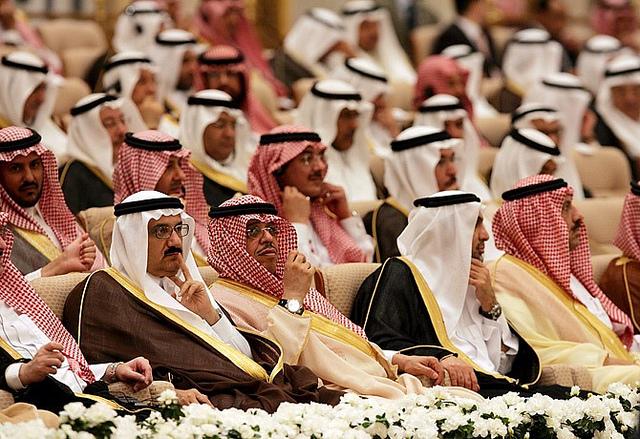
A cold war is taking place in a very hot place. A key component of the sectarian competition between Shia and Sunni Islam in the Middle East is geopolitical, with Iran facing off against Saudi Arabia and its Gulf allies in a struggle for regional dominance.
As with the original Cold War between the Soviet Union and the United States, the conflict does not involve direct military confrontation between the main rivals, at least not yet. It is being fought diplomatically, ideologically, and economically—especially in the oil markets—and through proxy wars, such as the conflicts in Syria and Yemen. There are few problems in the wider Middle East that cannot be traced back to the power rivalry between Saudi Arabia and Iran.
For the moment, the Iranians seem to be riding high. Following Supreme Leader Ayatollah Ali Khamenei’s decision to agree to an international deal limiting Iran’s nuclear capability to peaceful purposes, Western sanctions have been all but removed. Now that it is once again acceptable to do business with Iran, its ailing economy is set for a rebound. Meanwhile, Iran’s creeping de facto annexation of parts of Iraq—astonishingly, with American acceptance—continues because no one except the so-called ‘Islamic State’ has the stomach to stand up to it.
Iran also has an overwhelming manpower advantage, with a population of an estimated 77 million, compared to Saudi Arabia’s 28 million. And while its army is far less well equipped than its rival’s, it is much larger. Moreover, Iran’s main Arab ally, Syrian President Bashar al-Assad, has been given a reprieve as the conflict in his country drags on without conclusion.
This has left the Saudis feeling abandoned and vulnerable. They believe that their great traditional ally, the US, betrayed them by concluding the nuclear deal with Iran. Meanwhile, they fear that the chaos in neighboring Iraq has exposed them to chronic strategic risks.
The Saudis are also recoiling under a barrage of criticism of their Wahhabi brand of Islam, which is widely blamed for incubating extremism and inspiring terrorism. Meanwhile, Saudi Arabia’s human rights record—including the denial of elementary rights for women—is under constant scrutiny.
Against this background, the Kingdom is taking the fight to its enemies. King Salman bin Abdulaziz Al Saud is the country’s above-the-fray ruler, but his son, Prince Mohammad bin Salman Al Saud, currently wields much of the power.
As Minister of Defense, Mohammad has continued the Saudi policy of backing anti-Assad rebels in Syria, in concert with Turkey, while unleashing a war on pro-Iranian tribesmen in Yemen (at an enormous humanitarian cost). He has also backed, if not instigated, an increase in domestic repression, and has launched an economic offensive against Iran—the consequences of which have been seen, until recently, in plunging global oil prices.
In early May, Saudi Arabia’s longstanding oil minister, Ali al-Naimi, was replaced by Khalid al-Falih, an ally of Mohammad’s. The reshuffle is an indication of Mohammad’s determination to use oil prices as a weapon against Iran and its ally, Russia. As the world’s swing producer, with boundless reserves of cheaply extractable oil, Saudi Arabia can flood or throttle the market at will.
And for now, the Saudis are flooding the market. They are seeking to rein in Iran and Russia, both of which need higher oil prices to sustain economic growth. And they are hoping to bankrupt the US shale-oil producers that have reduced America’s dependence on Middle Eastern oil. As Mohammad recently declared, the Kingdom doesn’t care about oil prices; ‘$30 or $70 – they are all the same to us’. Iran and Russia, by contrast, need a barrel of oil to be worth at least $70.
The US oil industry has proved more adaptable and resilient than expected; cheaper shale fields have opened even as old ones have closed. But the Saudi oil offensive has helped convince Iran and Russia to drag Assad, kicking and screaming, to the negotiating table.
Mohammad’s new economic plan, Vision 2030, unveiled in May, is another front in the economic war, designed to show that Saudi Arabia is immune to the domestic economic pressures afflicting Iran and Russia. The plan calls for economic diversification and envisages the establishment of a huge sovereign wealth fund to cushion the impact of lower oil revenues that the ruling class has traditionally used to purchase social peace.
The Saudi strategy is not without its costs. Gulf remittances of around $10 billion a year to Egypt (itself under increasing economic pressure and a dizzying fall in tourist receipts after recent terrorist attacks) have been scaled back to around $3 billion. And funding to Lebanon has been cut almost completely.
And yet the long-term outcome of this cold war is not hard to predict. Iran and Russia can never be more than foothold powers in the Arab world. The Shia might be able to maintain influence in Iraq, Syria, and Lebanon (through Hezbollah), but they will be unable to compete more broadly. Some 90% of Arabs are Sunni Muslims, and thus potential Saudi allies.
The Saudis can afford to be more mature, and less suspicious than they have been. The US should take steps to reassure them—while never easing up pressure to improve human rights and implement political and economic reforms.